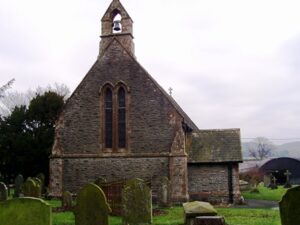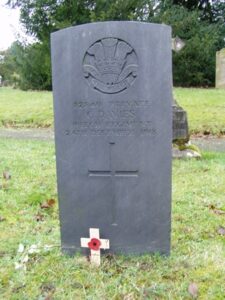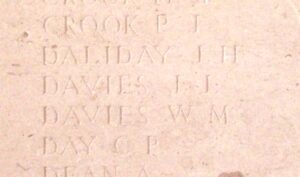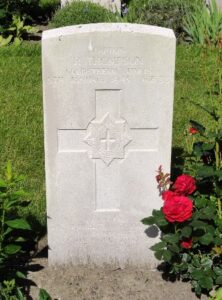Kinnerton is a small village situated on the eastern edge of Radnorshire, near the English border. The village contains the remnants of an ancient motte and bailey castle. Within the village sits St. Mary’s Church, inside of which is a war memorial to the men of the village who fell during the Great War, plus the one local man who fell during World War Two. These same men are also commemorated on a separate memorial within Kinnerton Jubilee Hall.

The Great War, 1914-1918
Cyril Davies, Private, 82840, Welsh Regiment. Cyril was the son of Josiah and Margaret Davies, of The Green, Llanfair Waterdine. He had enlisted into the Welsh Regiment at some time in 1918 and was posted to Aldershot for training. He did not serve overseas, but took ill and died of pneumonia at Connaught Hospital, Aldershot on 24 December 1918, aged 21. His remains were brought home and he was buried at St. Mary’s Churchyard, Kinnerton. His brother, Josiah, had been killed in 1917.

Josiah James Davies, Private, 39551, South Wales Borderers. Josiah was the son of Josiah and Margaret Davies, of The Green, Llanfair Waterdine. He enlisted at Pontypool into the Monmouthshire Regiment, but was transferred into the 2nd Battalion, South Wales Borderers upon his arrival in France in the summer of 1916. The battalion was attached to 87 Brigade, 29th Division. The division had suffered terrible casualties during the Battle of the Somme, assaulting Y-Ravine on the opening day. The division remained in the Somme area until the beginning of February 1917 when it began to move out of the line before heading slightly north and from 12 April spent its first tour in the trenches at Monchy. In the Spring of 1917, the division took part in the opening of the Battle of Arras. During the opening morning of the battle, at 04.45 on 23 April 1917, the 2nd SWB went over the top and assaulted the German front line at Monchy-Le-Preux, capturing and consolidating their gains during the afternoon. Josiah was killed in action at some time during the day. He was 22 years old and is commemorated on the Arras Memorial, France. His brother, Cyril died on active service the following year.

Arthur Sidney Evans, Private, 131742, Machine Gun Corps. Arthur was born on 4 January 1899, the son of Thomas and Sarah Evans, of Pool House, Kinnerton. He worked as a railway porter at New Radnor prior to enlisting into the army and was posted to the 63rd Battalion, Machine Gun Corps. The battalion was attached to the 63rd (Royal Naval) Division, which was formed to utilise the extra manpower which had been released due to the Royal Navy having more sailors than ships to place them on, and first saw service at Antwerp in August 1914 and then at Gallipoli in 1915. The division saw heavy fighting on the Somme, during the Battle of the Ancre in 1916 and in 1917 fought at the Battles of Arras, Passchendaele and Cambrai. The division was in the Arras area when the Germans launched their Spring Offensive on 21 March 1918 and took part in heavy fighting in the coming days. Arthur was killed during this terrible period, on 5 April 1918, aged 19. He is buried in Englebelmer Communal Cemetery, France.
Thomas Stanley Jones, Private, 18134, King’s Shropshire Light Infantry. Thomas was born at Four Stones, Old Radnor, the son of James and Mary Jones. The family later resided in Ross Hurst, Presteigne. Thomas worked as a horseman at Trewern prior to enlisting at New Radnor into the King’s Shropshire Light Infantry, and was posted to the 1st Battalion, King’s Shropshire Light Infantry, which was attached to 16 Brigade, 6th Division. The division had been in France since 10 September 1914 and had fought on the Aisne. During 1915 it had seen terrible fighting at Ypres, during the Action of Hooge and in 1916 moved to the Somme, where the Division fought at the Battle of Flers-Courcelette, the Battle of Morval and the Battle of Le Transloy. The following year saw the division at Arras, where it fought at the Battle of Hill 70. Thomas was probably wounded during heavy fighting near the Crassiers on 22 April 1917. He died of his wounds at Bethune on 29 April 1917, aged 20 and is buried in Bethune Town Cemetery, France.
William Thomas Jones, Private, 208168, Sherwood Foresters. William was the son of William and Emma Ann Jones, of Yonkin Farm, Kinnerton. He enlisted at Hereford on 29 February 1916 into the Herefordshire Regiment, and was posted to Pembroke Dock where he trained as a signaller. On 31 March 1918 he embarked at Southampton and disembarked at Rouen on 2 April 1918. William was then transferred to the 1/4th Battalion, King’s Shropshire Light Infantry, before being transferred again, to the 15th Battalion, Notts & Derby Regiment on 9 April. The battalion was attached to 105 Brigade, 35th Division, and during the final year of the war fought at the First Battle of Bapaume, during the German Offensive. The division was then moved back north, and fought later in the year during the great offensive, reaching the line of the River Dendre when the armistice halted the fighting at 11.00 on 11 November 1918. The Division was withdrawn towards Ypres, and by 2 December 1918 was near St-Omer. Here it began to demobilise, and William returned home to Yonkin Farm. Sadly, the war had taken its toll on his health, and he died at home on 8 February 1919, aged 28. Little else is currently known of him, as he is not commemorated by the CWGC, but he is possibly buried in St. Mary’s Churchyard.
World War Two, 1939-1945
Robert Thompson, Captain, 247093, Coldstream Guards. Robert was the son of Samuel Harold Thompson and Ethel Matilda Thompson (nee Astbury), of Newcastle Court, New Radnor. He married at some time after the outbreak of war and lived with his wife Mary Thompson, at Green End, Presteigne. Robert was a Chartered Land Agent prior to being commissioned into the Coldstream Guards on 3 October 1942. The Coldstream Guards had been converted to serve as armoured troops during WW2, and formed parts of the Guards Armoured Division, serving in North Africa and Italy before being recalled to Britain to prepare for the Normandy landings. The division landed in Normandy at the end of June 1944 and took part in the break-out from Normandy and the subsequent drive northwards through France into Belgium and Holland, playing a prominent part in Operation Market Garden. Robert died in Belgium just before the division began its advance into the Reichswald Forest, on 5 January 1945, aged 33. He is buried in Geel War Cemetery, Belgium. The inscription at the base of his headstone reads: ‘I LOOK FOR THE RESURRECTION OF THE DEAD AND THE LIFE OF THE WORLD TO COME’.
